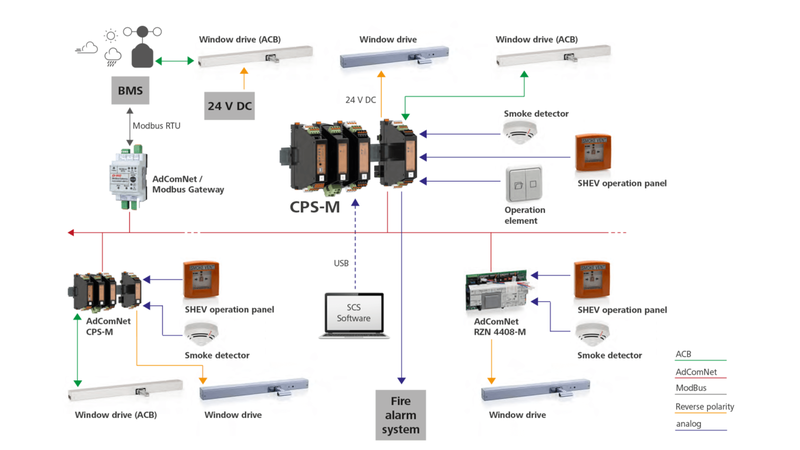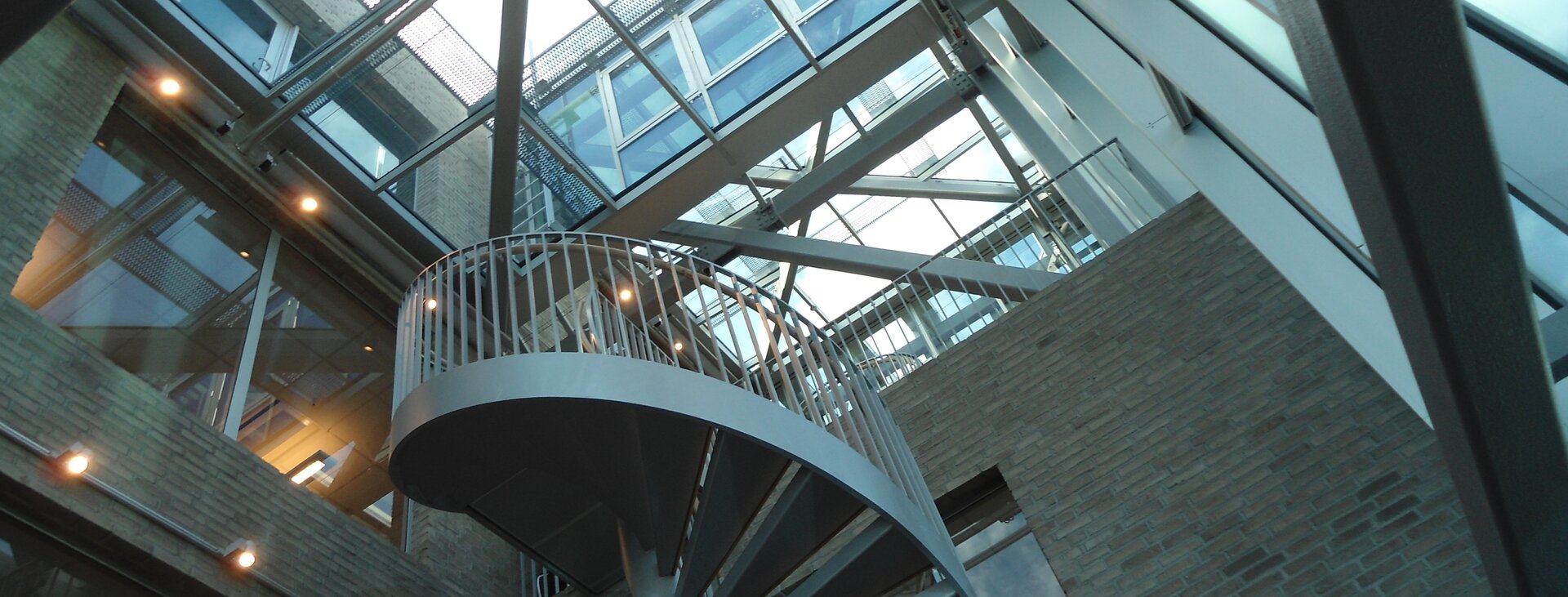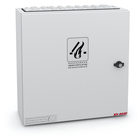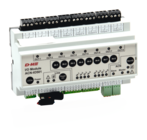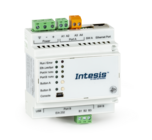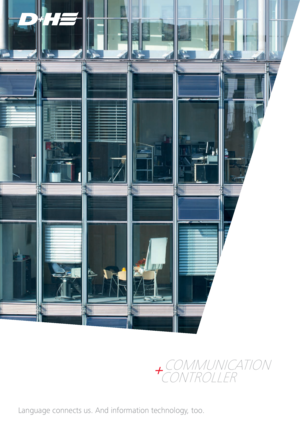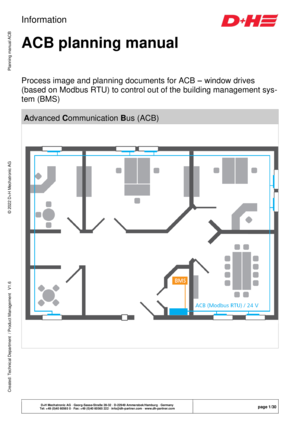What does bus communication mean at D+H?
Intelligent control + Cost-effective planning
In a general sense, the term 'bus' in information technology refers to a system for transmitting data between multiple nodes in a network using a shared transmission path. Today, there are many different kinds of bus systems, such as in cars (CAN bus) or in smart homes (KNX, LON, BACnet etc.). In most cases, the most important nodes in a smoke vent and ventilation network are a building management system, the window drives and, if necessary, the control panels.
Protocols are used as transmission paths in order to meet the requirements for system-internal, secure and stable communication. These protocols can be transported both via radio signals or via cable. Using the same protocol, the individual devices can 'talk' to each other, i.e. exchange information – in other words, 'bus communication'.
In the D+H product range you will find two bus technologies: AdComNet (ACN) for communication between controllers, and AdComBus (ACB) for communication between drive and controller. D+H bus technologies are based on Modbus, allowing them to be integrated in virtually any building management system.
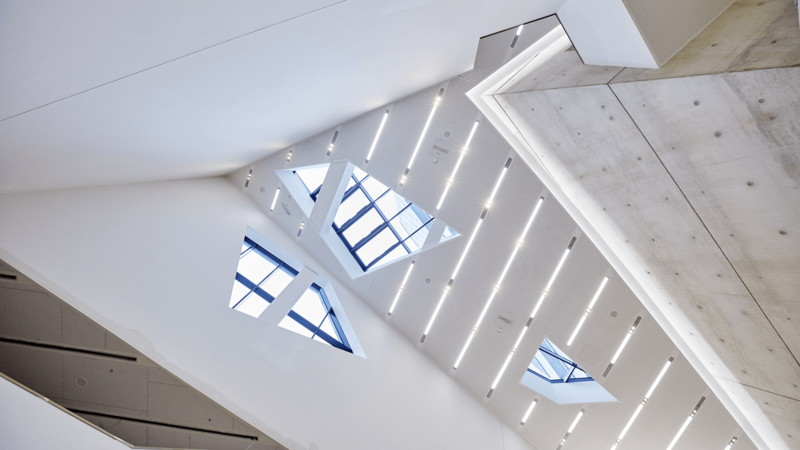
ACB + ACN
The two bus systems of D+H
The Advanced Communication Bus (ACB/AdComBus), by contrast, is based on the Modbus RTU protocol and regulates communication between controllers and drives rather than between controllers. ACB should therefore be understood as being an enhancement to AdComNet. For pure ventilation purposes, ACB drives can be operated directly from the building management system. The integration of a CPS-M – the digital SHEV control panel from D+H – is always necessary for SHEV functions.
The benefits of AdComBus
-
Direct control of the drives using the building management system
-
Individualised control of multiple drives on a single cable
-
One-percent position control accuracy
-
Feedback on the actual position of the drives
-
Optimum display of possible error messages
-
Fewer cables and less wiring effort thanks to bidirectional communication
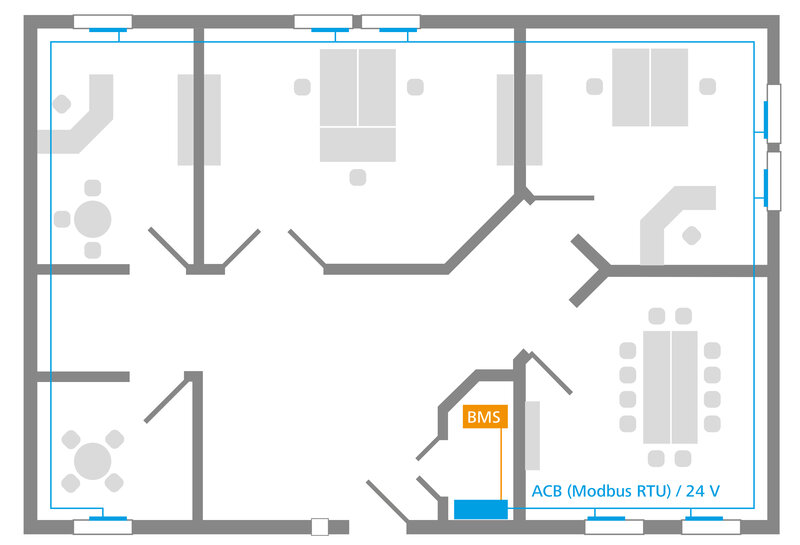
The Advanced Communication Network (ACN/AdComNet) is the first SHEV bus system to be certified by VdS. This technology allows SHEV controllers to be combined to form a single decentralised and overarching system. The controllers are linked in such a way that complex scenarios can be configured depending on space utilisation, i.e. individualised smoke compartments for opening and closing windows.
The benefits of AdComNet
-
Large potential for savings thanks to reduced wiring effort and expense
-
Reduction of cable cross-sections and lengths
-
Only a tenth of the usual power consumption per node
-
No special power supply required if the mains power fails
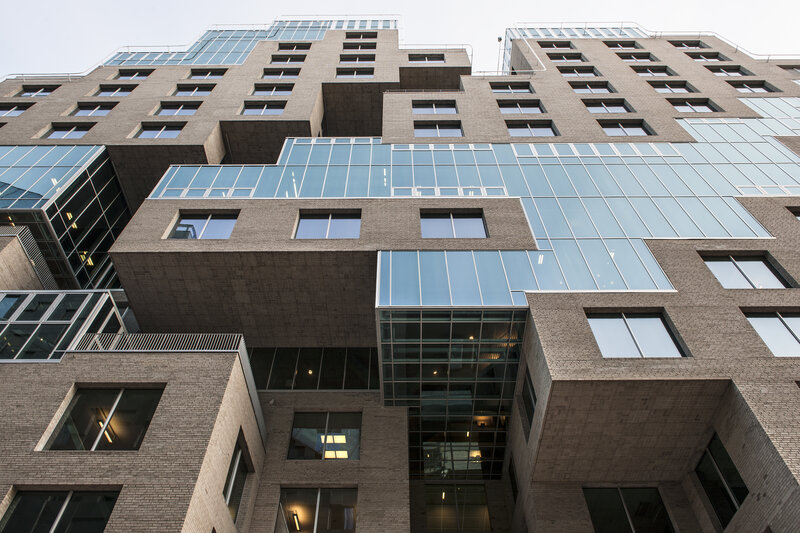
Modular system architecture at DNB Bank in Oslo: The innovative AdComNet solution from D+H ensures an extremely flexible use of space despite the necessary reduction in cable lengths and cross-sections. The intelligent AdComNet control system ensures cost-effective building operation. As a result, only a tenth of the usual power consumption per node is required.
Our products for building your solution with a D+H bus communication network
AdComNet - With the best connections
ACN solution at Avantra Residential Buildings
The luxurious Avantra Residences consist of two high-rise buildings with a complex D+H system solution for natural ventilation and smoke and heat exhaust ventilation in the event of fire. D+H partner EBSA Pty Ltd succeeded in implementing smoke and heat exhaust ventilation, ventilation and fire protection for one of Australia's largest construction projects, the Avantra Residences. The housing complex makes use of 766 D+H chain drives, controlled by 463 D+H ventilation buttons. The 336 skylight drives are networked over the D+H ACB Modbus system and can open the skylights to a full 90 degrees.
290 compact D+H SHEV control panels and 20 digital D+H smoke vent control panels - in housings specially designed for outdoor use - control this large-scale system with around 18 km of AdComNet bus cables in total. Despite the multitude of components and fire protection zones, the focus of the project from the outset was economical operation and maintenance of the entire smoke extraction and ventilation system.








AdComBus - Automatically more fresh air
ACB solution at the Glucksman Library
The Glucksman Library at the University of Limerick is one of the largest campus libraries in Ireland, and one of the most digitally advanced in the world. In 2018, the existing building received a 7,600 square metre addition, and was also radically redesigned. To enable a healthy, focused work atmosphere, the Irish partner of D+H, Window & Door Accessories, handled the installation and commissioning of a window automation system.
The project consists of 246 CDC-1-ACB 24 V chain drives operated directly by the building management system via Modbus. Using ACB technology , the building management system can control each window with perfect positioning, either individually or in groups. The opening and closing speeds of the drives can also be regulated separately. Thanks to their scarcely audible operating noise, D+H drives ensure a comfortable learning environment and an optimal indoor climate at all times.

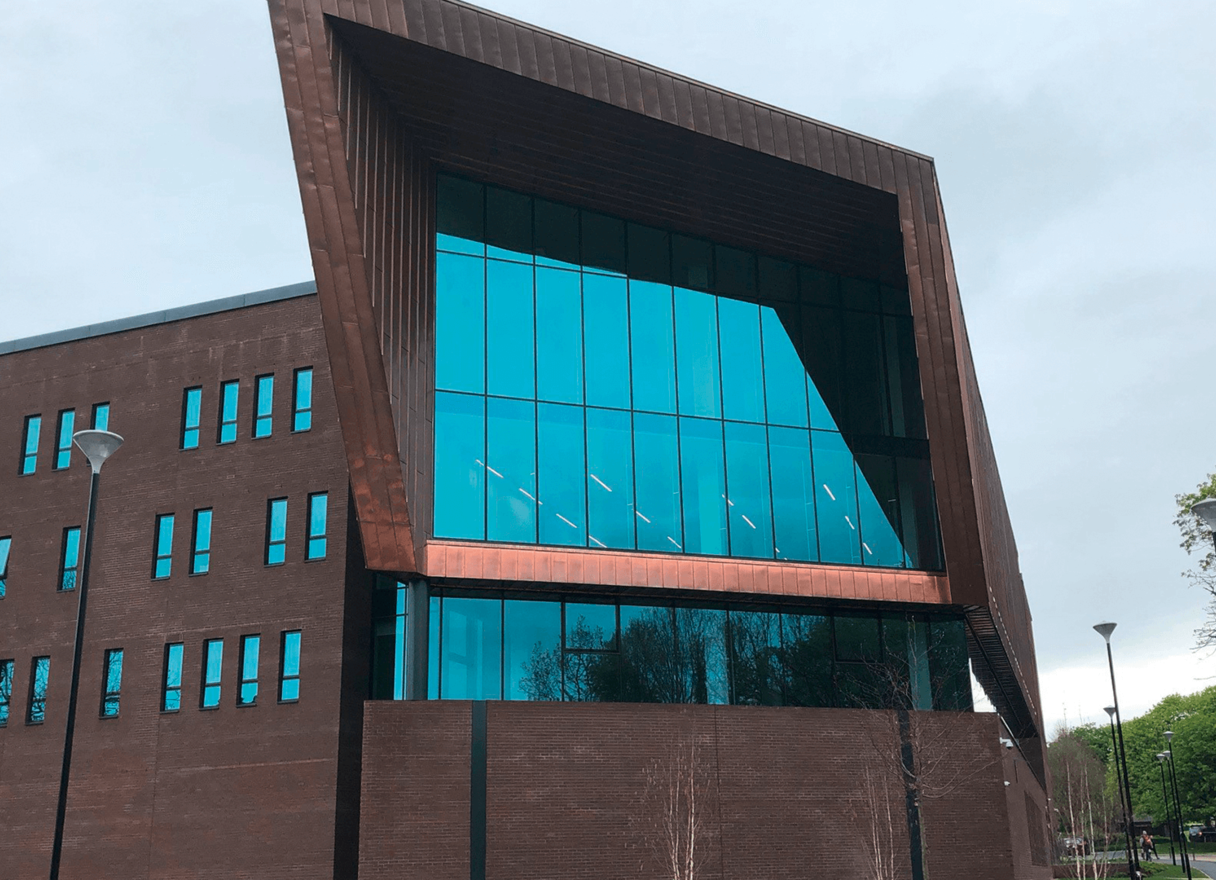
The Glucksman Library, which was completed in 2018, was designed by RKD Architects. The window automation was implemented by D+H's Irish partner Window & Door Accessories.


The opening and closing speeds of the drives can also be controlled individually. In reading and learning areas, for example, they operate extra slowly and quietly so as not to disturb students' concentration.
ACB – the D+H alphabet
Live communication with the drive: when windows learn to talk
The newly-developed Advanced Communication Bus (ACB) from D+H has revolutionised communication between window control systems and drives. Especially during major projects, building operators are often faced with the question "Do all the installed system components also work for smoke extraction and natural ventilation? And if not, where in the network does the problem lie?"
ACB allows the drives to communicate with the controllers and sends back information about opening width and status. However, this is just one major advantage of the innovative bus technology. Much less wiring is required, which reduces installation effort and costs, and makes it possible to specify control of the drives with millimetre precision.
-
Less cable to be routed thanks to bidirectional bus communication between D+H controllers and D+H drives using just one bus line
-
Synchronous operation of multiple drives on one opening element easy to implement
-
Extension and retraction of the chain controlled with millimetre precision
-
Quick and easy read-out of all status messages such as the opening stroke in mm or %, end position OPEN or CLOSED, optional messages for connecting closing edge protection, etc.
-
Direct integration into the BMS via open Modbus RTU protocol
-
Virtual grouping allows up to 32 drives to be controlled on just one cable, either as a group or separately, which reduces wiring and streamlines the control panel system
Our greatest incentive in creating the ACB was to optimise the functionality, flexibility and cost-effectiveness of SHEV control systems. In close collaboration with experienced technical experts, we spent many months working intensively on the development and embracing the exciting challenge of taking communication between drives and control panels to the next level. The status quo on the market was that most systems only allowed communication using the polarity of the output voltage in one direction: from the control panel to the drives. Our goal here was to make the drives talk to the control panel as well. They should be able to communicate with the control panel – without extra wiring!
We needed to create a technology that both reduced the size of our control panels (because no building operator likes large control cabinets) and featured higher performance capacity. The goal was for the ACB to be compatible with the conventional polarity change standard while also offering considerable functional advantages when combined with D+H drives and control panels.
We launched the ACB technology in 2016 along with the digital, fully modular CPS-M smoke vent control panel. Compared to the plug-in control panel technology, the CPS-M requires less than half the space. One reason for this is that each module has two group connections as opposed to just one, and the modules are far more compact than the plug-in units. Another reason is that the Advanced Communication Bus connects the drives to the control panel using only one group connection and one cable. Using conventional technology required laying an additional cable and using an additional group plug-in unit for every window that needed to be separately controlled. Reducing cable routing and cutting down on the number of modules provides a major cost advantage for our customers.
The CDC-ACB chain drive and the ZA-ACB rack and pinion drive are equipped with the new technology. Other D+H drive models are already being converted. Thanks to improved communication, the window drives no longer just receive instructions from the control panel. They also return information to the CPS-M about their status, connections and position. In addition, each individual drive can now be moved to a specific position. This is called bidirectional communication, and it provides the user with more functions while also making it easier to carry out maintenance work because it is significantly easier to read out information from the drives. With the ACB, this communication can be easily configured via the controller. Using conventional technology, this had to be carried out at the window drive itself. This was usually complicated because the drives are installed in areas of the building that are difficult to reach.
There are comparable technologies on the market that involve controlling drives from a control panel on a bus. These technologies differ greatly depending on the manufacturer. However, I see them all as having one thing in common: drive synchronisation and communication with the control panel take place on the same bus. In developing the ACB, we made a conscious effort to separate these two aspects from each other. Doing so has safety advantages and also allows us to individually control multiple synchronous groups on one ACB section. As far as I know, this is something that no other provider offers. Using conventional solutions here would mean either that only one synchronous group could be controlled on a group connection or that a separate bus cable would be required with an additional bus coupler for each synchronised group. Our solution integrates the bus coupler in the drives themselves. This way, 20 single drives can be controlled using one ACB section for SHEV, and as many as 32 single drives for natural ventilation.
Our ACB solution also means we are the only supplier to use an open protocol standard. This results in an entirely new field of application. As an example, building automation can directly control our drives individually and with perfect positioning for ventilation purposes.
Generally speaking, the term 'bus' in information technology refers to a system for transmitting data between multiple nodes in a network using a shared transmission path. The most important nodes in a SHEV and ventilation network are, in most cases, a building management system, the window drives and the control panels. Protocols are used as transmission paths to meet the requirements for system-internal, secure and stable communication. For the Advanced Communication Bus, this is based on the conventional Modbus RTU protocol. Why conventional? Over time, a wide variety of transmission systems have been developed by various manufacturers. On an international level, though, only some of these systems meet recognised standards. Modbus RTU is one of the protocols that meet international standards, qualifying it as an vital component within industrial communication.
As far as the structure of the ACB is concerned, we need a cable with four wires for connecting ACB drives. Two wires are for the power supply and the other two are for communication. As usual, this allows wiring to be routed through all drives in series. Another advantage of the ACB is worth mentioning here. This design does away with simple cable monitoring. Instead, each drive or drive group is monitored directly, providing an additional degree of security. Now, a fault is reported, for example, if a drive cannot open a window due to mechanical problems and an overload is detected.
The D+H rack and pinion drive is the perfect solution for the roof area. Equipped with a rugged rack and pinion, it has high pressure stability, allowing it to drive heavy flaps, skylights and windows without any difficulty. Of course, the recent addition of the ACB to the drive's equipment does not change this feature. The ACB simply makes the drive intelligent as well as powerful.
It is very easy to identify the advantages of the ZA-ACB, one of the many variations of the ZA, which was designed specifically for louvre windows. In particular, having millimetre precision control plays a major role here. In the summer, you might want the louvres to create a small gap by opening up only 12.9 % of the way. Alternatively, you might prefer an 80 % opening for a strong breeze to air the building? To implement this control with perfect positioning, the conventional rack and pinion drive previously required a wide variety of additional plug-in units and control panels. Today, all you need is a system consisting of the CPS-M and the ACB-capable drives. This, along with the ability to connect drive groups using just one connection and one cable, provides tremendous cost advantages for the customer, especially in the roof area. Installation also becomes much simpler.
Another example can be used to highlight the advantage of the function that allows you to control the drives within a group individually. Imagine, for instance, multiple offices along a façade with windows that open when using SHEV but are to be controlled individually for ventilation purposes. In the past, this set-up required a group connection at the control panel and separate wiring for each drive. Thankfully, the ACB, along with a concept called virtual grouping, makes this complicated scenario a thing of the past. Just one group connection and one cable are needed for all offices.
